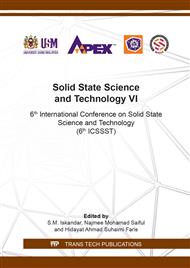[1]
H. Lin, L.R. Yao, Y.Y. Chen, H. Wang, Structure and Properties of Silk Fibroin Modified Cotton, Fibers and Polymers. 9 (2008) 113-120.
DOI: 10.1007/s12221-008-0019-z
Google Scholar
[2]
D. Sarawanan, N.S. Vasanthi, T. Ramachandran, A review on influential behaviour of biopolishing on dyeability and certain physico-mechanical properties of cotton fabrics, Carbohydrate Polymers. 76 (2009) 1-7.
DOI: 10.1016/j.carbpol.2008.10.019
Google Scholar
[3]
A. Hebeish, F.A. Abdel-Mohdy, M.M.G. Fouda, Z. Elsaid, S. Essam, G.H. Tammam, E.A. Drees, Green synthesis of easy care and antimicrobial cotton fabrics, Carbohydrate Polymers. 86 (2011) 1684-1691.
DOI: 10.1016/j.carbpol.2011.06.086
Google Scholar
[4]
A. Hebeish, M.E. El-Naggar, M.M.G. Fouda, M.A. Ramadan, S.S. Al-Deyab, M.H. El-Rafie, Highly effective antibacterial textiles containing green synthesized silver nanoparticles, Carbohydrate Polymers. 86 (2011) 936-940.
DOI: 10.1016/j.carbpol.2011.05.048
Google Scholar
[5]
F. Zhang, Y. Chen, H. Lin, H. Wang, B. Zhao, HBP-NH2 grafted cotton fiber: Preparation and salt-free dyeing properties, Carbohydrate Polymers. 74 (2008) 250-256.
DOI: 10.1016/j.carbpol.2008.02.006
Google Scholar
[6]
H.Y. Sun, J. Li, X.L Qiu, F.L. Qing, Synthesis and structure-activity relationship (SAR) of novel, Journal of Flourine Chemistry. 126 (2005) 1425-1431.
Google Scholar
[7]
S.W. Ali, M. Joshi, S. Rajendran, Novel, Self-Assembled Antimicrobial Textile Coating Containing Chitosan Nanoparticles, AATCC Review. 11 (2011) 49–55.
Google Scholar
[8]
B.D. Kalyon, U. Olgun, Antibacterial efficacy of triclosan-incorporated polymers, American Journal of Infection Control. 29 (2011) 124–125.
DOI: 10.1067/mic.2001.113229
Google Scholar
[9]
T. Jiang, L. Liu, J. Yao, In situ deposition of silver nanoparticles on the cotton fabrics, Fibres and Polymers. 12 (2011) 620–625.
DOI: 10.1007/s12221-011-0620-4
Google Scholar
[10]
M. Joshi, S. Wazed Ali, S. Rajendran, Antibacterial finishing of polyester/cotton blend fabrics using neem (Azadirachta indica): A natural bioactive agent, Journal of Applied Polymer Science. 106 (2007) 793–800.
DOI: 10.1002/app.26323
Google Scholar
[11]
G. Mary, S.K. Bajpai, N. Chand, Copper (II) ions and copper nanoparticles-loaded chemically modified cotton cellulose fibers with fair antibacterial properties, Journal of Applied Polymer Science. 113 (2009) 757–766.
DOI: 10.1002/app.29890
Google Scholar
[12]
M. Montazer, S. Seifollahzadeh, Enhanced self-cleaning, antibacterial and UV protection properties of nano TiO2 treated textile through enzymatic pretreatment, Photochemistry and Photobiology. 87(2011) 877–883.
DOI: 10.1111/j.1751-1097.2011.00917.x
Google Scholar
[13]
K. Vasilev, V.R. Sah, R.V. Goreham, C. Ndi, R.D. Short, H.J. Griesser, Antibacterial surfaces by adsorptive binding of polyvinyl-sulphonate-stabilized silver nanoparticles, Nanotechnology. 21(2010) 215102.
DOI: 10.1088/0957-4484/21/21/215102
Google Scholar
[14]
N. Xia, Y. Cai, T. Jiang, Green synthesis of silver nanoparticles by chemical reduction with hyaluronan, Carbohydrate Polymer. 86 (2011) 956–961.
DOI: 10.1016/j.carbpol.2011.05.053
Google Scholar
[15]
L.Y. Tan, L.T. Sin, S.T. Bee, C.T. Ratnam, K.K. Woo, T.T. Tee, A.R. Rahmat, A Review of Antimicrobial Fabric Containing Nanostrutures Metal-Based Compound, Journal of Vinyl & Additive Technology.
DOI: 10.1002/vnl.21606
Google Scholar
[16]
A. Aou-Okeil, A.M. Sheta, A. Amr, M.A. Ali, Wound dressing based on nonwoven viscose fabrics, Carbohydrate Polymers. 90 (2012) 658-666.
DOI: 10.1016/j.carbpol.2012.05.093
Google Scholar
[17]
T. Koyano, N. Koshizaki, H. Umehara, M. NAgura, N. Minoura, Surface states of PVA/chitosan blended hydrogels, Polymer, 41 (2000) 4461–4465.
DOI: 10.1016/s0032-3861(99)00675-8
Google Scholar
[18]
A. Stankovic, S. Dimitrijevic, D. Uskokovic, Influence of size scale and morphology on antibacterial properties of ZnO powders hydrothemally synthesized using different surface stabilizing agents, Colloids and Surfaces B: Biointerfaces, 102 (2013) 21-28.
DOI: 10.1016/j.colsurfb.2012.07.033
Google Scholar
[19]
M. Shaban, S. Abdallah, A.A. Khalek, Characterization and photocatalytic properties of cotton fibers modified with ZnO nanoparticles using sol–gel spin coating technique, Journal of Applied Sciences, 5 (2016) 277-283.
DOI: 10.1016/j.bjbas.2016.08.003
Google Scholar
[20]
H. Barani, Preparation of antibacterial coating based on in situ synthesis of ZnO/SiO2 hybrid nanocomposite on cotton fabric, Applied Surface Science. 320 (2014) 429-434.
DOI: 10.1016/j.apsusc.2014.09.102
Google Scholar
[21]
M. Rana, B. Hao, L. Mu, L. Chen, P.C. Ma, Development of multi-functional cotton fabrics with Ag/AgBr-TiO2 nanocomposite coating, Composite Science and Technology. 122 (2016) 104-112.
DOI: 10.1016/j.compscitech.2015.11.016
Google Scholar
[22]
L.T. Sin, S.T. Bee, T.T. Tee, A.A.H. Kadhum, C. Ma, A.R. Rahmat, P. Veerasamy, Characterization of α-tocopherol as interacting agent in polyvinylalcohol–starch blends, Carbohydrate Polymers. 98 (2013) 1281-1287.
DOI: 10.1016/j.carbpol.2013.07.069
Google Scholar
[23]
H.E. Emam, N.H. Saleh, K.S. Nagy, M.K. Zahran, Functionalization of medical cotton by direct incorporation of silver nanoparticles, International Journal of Biological Macromolecules. 78 (2015) 249-256.
DOI: 10.1016/j.ijbiomac.2015.04.018
Google Scholar


